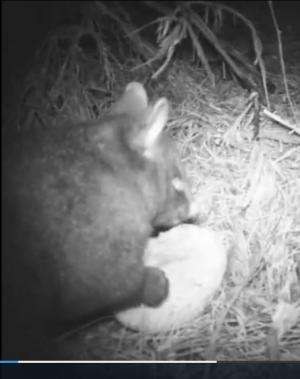Exotic mammals may play key role in the spread of invasive pines throughout New Zealand (w/ Video)

New research has found exotic mammals, such as deer and possums, may be playing a major role in assisting wilding conifers invade new sites around New Zealand.
The study, led by Dr Jamie Wood at Landcare Research, was recently published in the Journal of Ecology.
Invasive conifers have a close relationship with fungi that grow on their roots (called ectomycorrhizal fungi), which can provide several benefits to the trees such as increased access to nutrients or drought tolerance. Without these beneficial fungi, the trees struggle to become established, and therefore wouldn't be a problem.
"So, the dispersal of spores of ectomycorrhizal fungi is really a critical factor determining how quickly these trees can spread across our landscapes" co-author Professor Ian Dickie of the Bio-Protection Research Centre at Lincoln University said.
"Elsewhere in the world it has been shown that mammals play a large role in eating mushrooms and dispersing fungal spores. So, we decided to look into whether mammals were helping spread the spores of these fungi in New Zealand," Dickie said.
Using motion-sensor cameras placed beside mushrooms, the team were able to capture video evidence of both deer and possums eating ectomycorrhizal fungi in pine forest.
"We were quite amazed by the video evidence, which showed consumption of mushrooms commonly regarded as toxic, such as the red and white spotted fly agarics. One deer in particular, filmed in the middle of the night, seemed to be seeking out the mushrooms by smell", Wood said.
But the most surprising results came when they analysed dung of these mammals to see how commonly these fungi appeared. Every dung analysed contained EMF fungal DNA, with up to 10 genera represented.
"By applying the dung to seedlings in a glasshouse experiment we were also able to confirm that the fungal spores were viable, with high rates of fungal inoculation observed in seedlings of invasive pine species," Wood said.
Deer and possums frequently move between forests and grasslands, spreading spores into new habitats and allowing pines to become established. Although the study only looked at deer and possum, it is likely that other exotic mammals such as pigs and hedgehogs could also be dispersers of the fungi, Wood said.
"What this study shows is that invasive tree species don't invade alone, but rather they are helped by both invasive fungi and invasive mammals that disperse these fungi. This highlights that interactions amongst invasive species can be mutually beneficial, also termed 'invasional meltdown'," he said.
Co-author Duane Peltzer of Landcare Research said the findings might also have practical implications.
"Management aimed at slowing or containing invasive trees might be more successful if animals are controlled at the same time. Although this idea was not tested here, there is an intriguing possibility that managing animal invaders concurrently with invasive trees might slow the spread or allow containment of wilding conifers".
Invasions of exotic species are a major driver of global change, and can have profound effects on native species and ecosystems. Internationally, some of the most widespread and problematic of these invaders are tree species that have been introduced for forestry but subsequently have become weeds. In New Zealand, several tree species, originally introduced for erosion control or plantations, have become major invaders with the potential to transform landscapes, perhaps the most obvious of which are wilding conifers (pines). Current estimates put the area invaded by these trees at well over a million hectares, and conifer spread shows no sign of slowing at a national scale.
More information: Jamie R. Wood, Ian A. Dickie, Holly V. Moeller, Duane A. Peltzer, Karen I. Bonner, Gaye Rattray, Janet M. Wilmshurst. 2014. Novel interactions between non-native mammals and fungi facilitate establishment of invasive pines. Journal of Ecology. DOI: 10.1111/1365-2745.12345.
Journal information: Journal of Ecology
Provided by Landcare Research


















